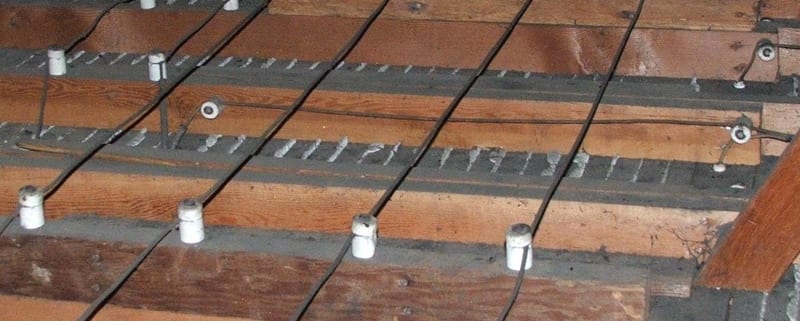Old Wiring and Knob & Tube Wiring
When inspecting an older home, the home inspector may come across the original old wiring and knob & tube wiring when the home was built. A high number of electrical fires can occur in these older homes. Having proper over-current protection can help prevent insulation failures, though in some cases time and exposure can take a toll on the wiring, and the wiring must be replaced. Fuses were generally used in older homes to provide overcurrent protection but they had to be properly sized. It was very common and very easy to bypass the proper protection by using a let’s say a penny being used behind the fuse.
using a let’s say a penny being used behind the fuse.
Insurance companies will typically require upgrading of older ceramic fuse panels and panels with cartridge fuses because of the risk of electrocution because of the exposed contacts. Below are the references from the 2011 NEC
- No exposed contact fuse holders
- Edison base (plug fuses) cannot be used for 240V circuits
- Type S fuse is required if tampering or over- fusing exists
- Type S fuse adapter must be the proper size for the wire
- Fuses are not allowed in the neutral conductor
The oldest wiring method in American residential homes is Knob and Tube wiring (K&T). When K&T is left in its original state, it can be reliable and safe. As a wiring method in un-insulated joists and stud cavities it is protected from damage and is provided with air circulation around the wires so heat does not build up. Unfortunately, when these systems are modified by unqualified persons, the safety of K&T is often compromised. When people add new loads to an old system it is tricky and seldom done correctly. The rubber insulation on K&T wiring becomes brittle over time and is prone to mechanical damage, especially when thermal insulation is added to an attic. Older rubber insulation has only a rating of 60 degrees Celsius or 140 degrees Fahrenheit. Below are references from the 2011 NEC
- No new K&T can be installed
- Additions to existing K&T are permitted if properly protected
- Must enter plastic boxes through separate holes
- Must be protected with loom where entering box
- Loom must extend from last insulator to ¼” inside box
- Do not envelop with thermal insulation.
- Wires must be kept out of direct contact with wood framing
- Tubes are required where wires pass through framing members
- 3” minimum between wires, 1” to surfaces
- Conductors on sides (not face) of exposed joists and rafters EXC
- Okay on edges or faces of rafters or joists in attics less than 3’ high
- Protect with running boards up to 7’ high in attics with stairs
- Provide protection were exposed less than 7’ above the floor
When inspectors encounter K&T wiring it is recommended that a qualified licensed electrical contractor/electrician evaluate the K&T wiring and repair/replace it as needed.
Information provided by the NEC 2011 Edition and the Complete Code Check Book
Signature Home Inspection is a Certified Home Inspection service located in California serving Orange County, San Diego County, Los Angeles County, Riverside County, Santa Clara County, San Mateo County, San Francisco County, Contra Costa County, and San Bernardino County California.
www.signaturemore.com 888-860-2688




Leave a Reply
Want to join the discussion?Feel free to contribute!